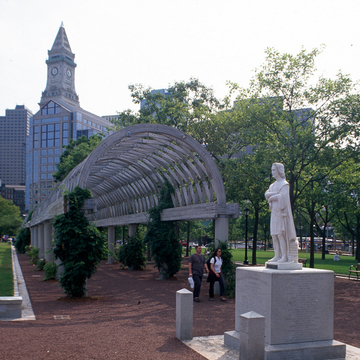Organizing by the Italian community in the North End led to the erection of a Christopher Columbus statue (Andrew J. Mazzola, 1979) and subsequently to the naming of the four-acre park. With the complete depression of the Central Artery, the park has become an important link in the Walk to the Sea, beginning in the Government Center complex, passing through Quincy Market (GC5), and on to the harbor channel, reinforcing the maritime heritage of the city. A rich variety of plantings enhance the landscape, while
A long wooden trellis framing an open arcaded promenade is the defining element of the park. Seating areas are found beneath the vaulted arbor and along the waterfront, and the whole is paved with bricks and cobblestones. Granite columns and aligned bollards enhance the nautical metaphor. A shingled park maintenance/administration building with vaguely Greek Revival massing and adjacent playground were added in 2003. Provisions for pleasure, play, and peaceful moments contribute to continuous usage and enjoyment by local inhabitants and tourists alike.















